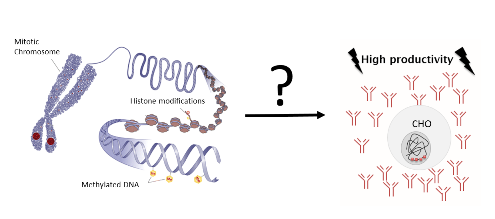Productivity optimisation of CHO cells by epigenome alterations
SUPERVISOR: NICOLE BORTH
Background.
Chinese hamster ovary (CHO) cells are the main workhorses in today's production of therapeutic proteins as approximately 70 % of all recombinant protein therapeutics are expressed in CHO cells (Walsh, 2014). The huge popularity of CHO is mostly due to their ability to generate human-like posttranslational modifications on recombinant proteins, their adaptability to grow in serum-free suspension cultures and to the fact that they have been shown to be safe production hosts (Fischer et al., 2015).
Nevertheless, the development of production strains is still a slow-going process as high variability and instability of subclones often demands high screening efforts to find and establish the best cell line. A major cause for such high screening efforts is that one usually observes high production rates after initial transfection, but most of these high producing cells are unstable and die in early stages, due to the stress of high production loads before they have time to adapt to these requirements.
As the pattern of expression of genes determines the cell's behaviour (phenotype), there are many different regulatory systems present that tightly govern and fine-tune gene expression, including transcription factors and epigenetic modifications. For CHO cells it has been shown that epigenetic changes play a crucial role in cell development and adaptation (Feichtinger et al., 2016). Therefore, in this project we are investigating the manipulation of the epigenome for applications in cell line engineering and development.

Aims and methods.
Main objective of this project is to investigate how the epigenome influences the production phenotype of CHO cells and how changes in the epigenome can be employed in cell engineering / development of CHO cells. Epigenome alterations will be introduced randomly by the use of small molecule epigenetic modifiers or by interference with enzymes involved in epigenetic regulation, such as TET, HDAC or DNMT. As these random changes will probably lead to an increased phenotypic variety in CHO cell population, high producers will be sorted out with established cell sorting methods, such as the cold capture assay (Brezinsky et al., 2003), that have been shown to directly correlate with productivity. Interrogations of the transcriptome with RNA seq or microarray of these high producers can then shed light on up- or downregulated factors that may represent novel and unknown engineering targets which can be evaluated in rational genetic engineering approaches.
Additionally, a strategy to adapt CHO cells to high production loads will be developed. Therefore, a molecular tool for modulation of the production load is designed and constructed. In the end, this tool should be used in combination with the introduction of epigenetic changes to improve productivity.
Brezinsky SCG, Chiang GG, Szilvasi A, Mohan S, Shapiro RI, MacLean A, Sisk W, Thill G. 2003. A simple method for enriching populations of transfected CHO cells for cells of higher specific productivity. J. Immunol. Methods 277:141–155.
Feichtinger J, Hernández I, Fischer C, Hanscho M, Auer N, Hackl M, Jadhav V, Baumann M, Krempl PM, Schmidl C, Farlik M, Schuster M, Merkel A, Sommer A, Heath S, Rico D, Bock C, Thallinger GG, Borth N. 2016. Comprehensive genome and epigenome characterization of CHO cells in response to evolutionary pressures and over time. Biotechnol. Bioeng.
Fischer S, Handrick R, Otte K. 2015. The art of CHO cell engineering: A comprehensive retrospect and future perspectives. Biotechnol. Adv. 33:1878–1896.
Walsh G. 2014. Biopharmaceutical benchmarks 2014. Nat. Biotechnol. 32:992–1000.
Zaidi SK, Young DW, Montecino M, Lian JB, Stein JL, Wijnen AJ van, Stein GS. 2010. Architectural Epigenetics: Mitotic Retention of Mammalian Transcriptional Regulatory Information. Mol. Cell. Biol. 30:4758–4766.
